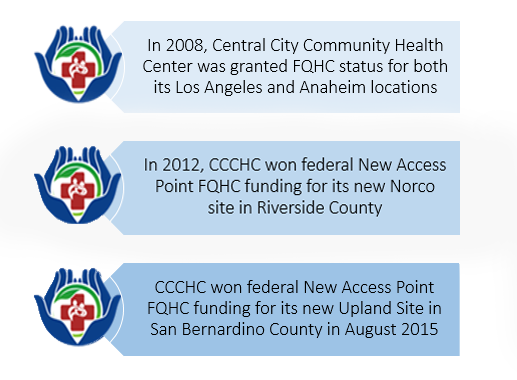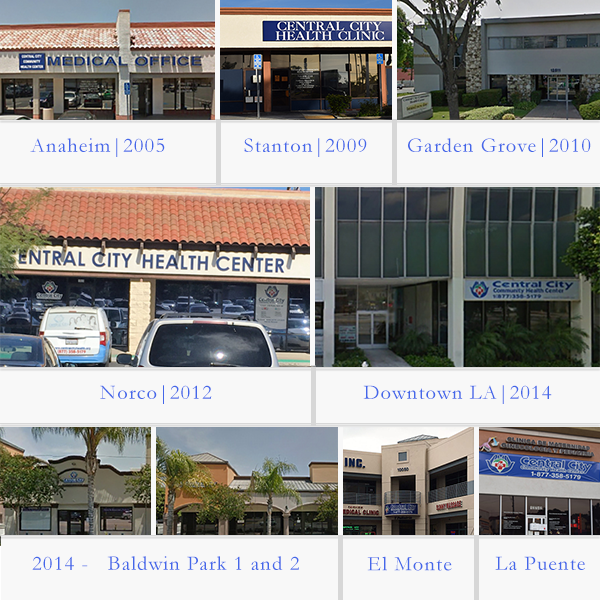Central City Community Health Center Founded in 1994
Organizational History, Awards and Program Services
In early 2015, CCCHC opened five additional clinics in the city of Indio, San Pedro, South Los Angeles, Anaheim and Inglewood. CCCHC won federal New Access Point FQHC funding for its new Upland Site in San Bernardino County in August 2015. The organization also operates mobile clinics in both Los Angeles and Orange County to serve hard-to-reach populations such as individuals and families experiencing homelessness and migrant and seasonal farm workers (MSFWs) as well as a mobile school-based health center in Anaheim and Santa Ana.
CCCHC currently provides comprehensive primary care, obstetrics/gynecology, family planning, mental health services, chiropractic care, family practice, pediatrics, podiatry, drug/HIV/STD testing, on-site Medi-Cal eligibility assistance, chronic disease management, and HIV/AIDS case management services. Services are also conducted through site-run prevention programs, including the Comprehensive Perinatal Services Program, Vaccine for Children Program, Child Health and Disability Program, Family Planning, Access, Care and Treatment (Family PACT), and its South Los Angeles-based mobile clinic provides the same care to area homeless shelters and residential facilities for mentally ill adults.
CCCHC was founded July 26, 1994, by a group of community advocates in South Los Angeles, with a mission “to provide quality health and human services to the medically underinsured and low-income population in a culturally relevant manner.” From 1994 to 2002, the clinic operated as a part-time licensed community clinic staffed by a physician assistant providing limited services.
In 2002, CCCHC underwent a board and management change and developed a growth strategy for the organization. CCCHC expanded services to Anaheim in Orange County in 2005, and in 2008, CCCHC was granted FQHC status for both its Los Angeles and Anaheim locations, a designation that attests to CCCHC’s organizational, financial, and medical effectiveness.
In 2009, CCCHC opened its Stanton site and in 2010, Garden Grove, to alleviate the pressure of increased patients and need for services in our Anaheim clinic in the same geographic area.
In 2012, CCCHC won federal New Access Point FQHC funding for its new Norco site in Riverside County and in June of 2014 CCCHC opened its Downtown Los Angeles site and San Gabriel Valley sites located in Baldwin Park, El Monte, and La Puente.
CCCHC delivers its core primary healthcare services through a Patient-Centered Medical Home model of “continuum of care” that is tailored to the individual’s own life-cycle segment through age appropriate screenings, vaccinations, education, and prevention programs. Programs have been developed in response to the increasing needs of indigent and immigrant populations, most of whom have a pattern of directing their focus on meeting basic needs rather than health issues. Those living below 200% of the FPL struggle to afford nutritious foods, insurance, vaccines, medications, and wellness checks, which often results in minor health issues developing into morbid conditions. Diseases and unique health conditions such as obesity, high blood pressure, mental health issues, and skin disorders have been identified in each service area and targeted for prevention. Timely diagnoses and comprehensive management early on translates to a better quality of life for patients and a reduction in cost to the health care system. With a proactive prevention and early intervention-focused orientation, CCCHC attempts to address community healthcare needs and to reduce health disparities by (a) increasing availability of primary medical services; (b) targeting chronic diseases through early identification and focused inquiry; and (c) increasing prevention and wellness programs. The impact of our services is reflected in improving compliance rates, and decreasing morbidity and mortality due to chronic illnesses.




